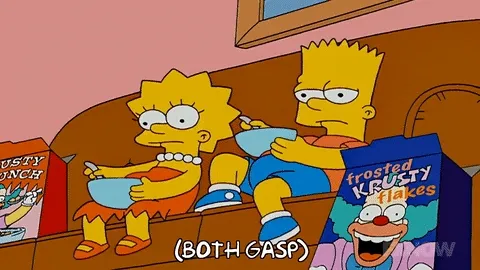Bitter sweet: Kellogg’s cereals just lost a regulatory fight in the UK
Kellogg’s, which pioneered foods that make health claims in the 1980s, just found itself ensnared in a UK regulation that targets unhealthy foods.

The Simpsons/Fox via Giphy
• 4 min read
Kellogg’s has always been ahead of the curve when it comes to food brands making health-related claims, and is even believed to be the first food company to have done so on packaging, when in 1984, it began linking high-fiber foods with a lower incidence of several cancers on boxes of All-Bran cereal.
But recently in the UK, some Kellogg’s cereals have been targeted for just the opposite, namely having high sugar content that could raise the risk of obesity for consumers who pour them into their bowls.
Embattled Creek: Kellogg’s UK, a subsidiary of the Battle Creek, Michigan-based Kellogg Company, had challenged proposed regulations that would ban products with high levels of sugar, fat, or salt from some supermarket discounts, including buy-one-get-one-free offers.
A judge ruled against the cereal maker, and the discounting restrictions are expected to take effect in October.
- Kellogg’s had argued that the proposed rule was unfair because it didn’t take into consideration that the cereals in question often are paired with milk.
- “We still believe that it is important that cereals are measured in a way which reflects how most people eat them—with milk,” Chris Silcock, the managing director of Kellogg’s UK, told the Guardian.
Marion Nestle, the author of books including Food Politics and a retired professor of nutrition, food studies, and public health at New York University, laughed about the milk-pairing argument.
“I love that!” Nestle told Retail Brew. “It’s really funny—people eat cookies with milk, too.”
Some Kellogg’s cereals actually are made up of a higher percentage of sugar per serving than some popular cookie brands:
- Honey Smacks contains 50% sugar (18 grams—more than 4 teaspoons—in a 36-gram serving size), while Smorz cereal contains 43.9% sugar.
- By comparison, Oreos, which claim they’re “Milk’s favorite cookie” on packaging, contain 41.2% sugar, while Chips Ahoy! cookies have 33.33% sugar.
Grant Thomas
Bowled over: The UK is not the only place where Kellogg’s is facing pushback.
- To limit marketing directed at children, Mexico has restricted using cartoon imagery or mascots on food packaging. In January, Mexican officials reportedly seized 380,000 boxes of Kellogg’s cereal that featured cartoons.
Retail news that keeps industry pros in the know
Retail Brew delivers the latest retail industry news and insights surrounding marketing, DTC, and e-commerce to keep leaders and decision-makers up to date.
But will restrictions like those in the UK and Mexico curtail how Kellogg’s promotes products in the US?
“We currently do not have plans to change how we market cereal in the US,” Kris Bahner, a Kellogg Company spokesperson, wrote in an email in response to an interview request. “Research shows regular consumption of cereal, including sweetened cereal, can be a tool for helping consumers, both kids and adults, achieve and maintain a healthier body weight while also helping them to meet recommendations for key nutrients.”
The statement continued, “We have a longstanding commitment to responsible marketing to children. As members of the Children’s Food and Beverage Advertising Initiative, we do not advertise to children younger than age six, and follow their nutritional criteria for any foods we market to children ages six to under 13.”
Nestle, the author, said that because of the food and beverage industry’s influence in Congress, Kellogg’s is unlikely to face the kind of regulatory restrictions in the US that it has elsewhere.
- Nestle noted that in 1980, after the Federal Trade Commission had proposed restrictions on television advertising targeted at children for snacks and other products, Congress passed a law that removed the FTC’s power to regulate such ads.
And Nestle doesn’t think much has changed today.
“How would you do that?” Nestle asked. “You’d have to have a government that was interested in public health. You’d have to have a government that was free of corporate interests so it could get past the lobbyists.”
Retail news that keeps industry pros in the know
Retail Brew delivers the latest retail industry news and insights surrounding marketing, DTC, and e-commerce to keep leaders and decision-makers up to date.